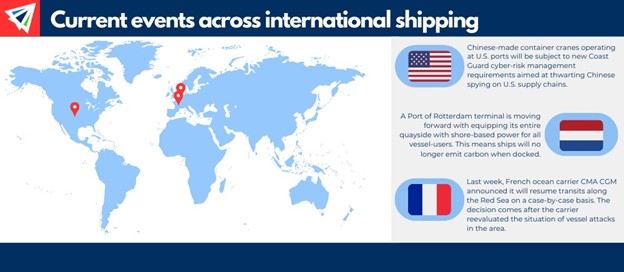
IMPORT: Asia to North America (TPEB)
Recent Developments:
- Ocean carriers did not implement general rate increases for the first half of March.
- While vessel congestion has not been a problem at East Coast ports, occasional episodes of vessel bunching have been reported the Port of New York and New Jersey. Read our archive of February’s Interlog Insights newsletter for more information!
Rates: Rates have softened into March. However, they remain disproportionately higher on containers bound for the East Coast.
Space: Space is mostly open but has tightened in pockets.
Capacity: Longer transit times around southern Africa (to avoid the Red Sea) are absorbing vessel capacity. However, carriers remain well-supplied with available vessels to manage the adjustment. There is no significant capacity crunch at this time.
TIPS:
- Hold your logistics partners accountable for frequent updates regarding current market conditions and routing impacts.
- Be flexible and adaptive to alternative service options, especially as it relates to potential savings on cost or transit.
IMPORT: Europe to North America (TAWB)
Recent Developments:
- Europe’s three largest container ports—Rotterdam, Antwerp, and Hamburg—have all reported sharp declines in volume for 2023. Their performances reflect a broader theme of economic anemia looming over Europe.
Rates: Rates are showing signs of receding in March. Low demand remains wielding influence over the market.
Space: Space is open.
Capacity: Capacity remains abundant. Carriers are partially curbing this by reducing the size of vessels operating on transatlantic lanes. Though, significant blank sailing programs have not been implemented.
Equipment: Availability on both origin and destination sides, unless advised otherwise.
TIPS:
- Book at least three weeks prior to the ready date.
- Communicate with your logistics partners to ensure that you’re up to speed on the EU ETS program and its evolving impacts on transatlantic trade.
- Keep an eye on carrier discretion when it comes to their managing of the market. While this trade favors shippers at the moment, carriers could become more aggressive with tactics, like rate increases or blank sailings, to prevent further lossmaking.
EXPORT: North America to Asia
Rates: Rates have creeped upward into March.
Capacity: Space remains open, particularly from West Coast ports, however carriers remain curbing capacity via blank sailings and slow steaming as U.S. import demand remains challenged.
Equipment: There are no significant deficits or bottlenecks, however coordinate closely with logistics partners as conditions may vary case by case.
TIPS:
- Insufficient communication with sailing schedules can lead to higher detention and demurrage fees as well as higher trucking and storage costs. Ensure your logistics partners are not keeping you and your cargo in the dark.